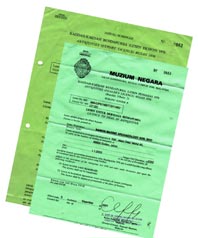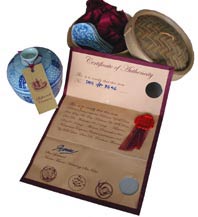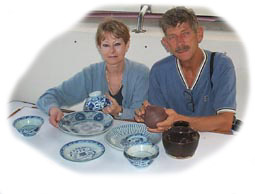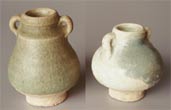Frequently Asked Questions
about Shipwrecks and antique Chinese porcelain and pottery
Is it legal to sell and to import shipwreck ceramics?
Our arrangement with the Malaysian government is such that all excavations are done in co-operation with its Ministry of Culture, Arts and Tourism and the National Museum. Under that arrangement, we finance all the search for shipwrecks, carry out the excavations and research and then produce the final reports. After sharing the recovered artefacts with the Government, we are allowed to sell our portion. As and when required, we apply for an Export Licence that allow us (or the buyer) to export the artefact from Malaysia. This permit will assist, not only export from Malaysia, but also import into certain countries demanding export license from country of origin.
How do you date shipwrecks and its ceramic cargo?
The loss of 14th to 16th century ships are not recorded and no survivor's reports can be found. It is therefore difficult to know when any single vessel sank. A search for the most likely date begins with an examination of the ceramic cargo that is part of every wrecksite thus far investigated. With a serie of such shipwrecks, it becomes possible to chronologically arrange the different ceramic cargoes based on known production sequence. After this, we compare technical as well as stylistic evidences by cross-referering with ceramics found on other dated shipwreck sites. Finally adding the ships construction details, design, wood used and known historical events leading to possible transfer of technologies and after a final comparison with carbon 14 dating, our dates for each shipwreck are likely to be as close as +/- 20 years.

Antique Dealer Licence is renewed once a year. Export Licence is obtained for every shipment when so required
Why are some shipwreck ceramics not as 'glossy' as antique pieces found elsewhere?
First of all, be careful with "antique" ceramics that looks new. It is pretty obvious that any historical artefacts will have some evidences of use. Earlier high-fired pottery are most often covered with a glaze containing iron oxides. If the ware is not fired at sufficiently high temperature to fully dissolve iron oxides in the glaze, it will crystallize on the surface. Once in contact with salt water, the crystals corrode, slowly pit the surface and eventually 'wear' the surface. The amount of deterioration often vary dependent on the duration of stay on the seabed. This effect is in fact, proof that the piece is old and that it has been recovered from the sea.
How are the shipwreck ceramics treated after recovery?
Centuries of submersion in salt water, at great pressure, allows salt to penetrate deep inside glaze cracks. This must be removed as it otherwise will destroy the surface. This is a rather complicated process that is best described as de-salination. By soaking the ceramics in fresh water for months and constantly monitoring the salinity levels, accumulated salt is eventually removed.
Calcarous growth is first mechanically removed. The affected areas are then washed with mild Hydrochroloic acid followed by repeated rinsing in destilled water.
Ceramics showing glaze-wear are sometimes stabilised with an acrylic solution. This coating does not affect the ceramics and, if so desired, can be removed by submersion in white spirit.
Also note that we do not repair damaged or chipped pieces. The only time we done so, the repair was noted in the Certificate of Authenticity.
How do I know that your shipwreck ceramics are
genuinely old?
Good question, as many manufacturers today know how to make newly made pieces 'look antique'. In some instances, they will bury their wares in the sea for a while, allowing seashells (most often barnacles) to grow on the surface. A trick that fool most buyers and sometimes experts as well.
Don't take our word for it. The Museums listed below, their professional personell and other independent scholars whom we often consult, will confirm that our shipwreck ceramics are real old and more accurately dated than most other ceramics on the markets. In addition to this, we issue a Certificate of Authenticity stating the age and the source of every item purchased. We also supply a small booklet with every piece, providing general background on the shipwreck and the objects manufacturing and history.
Where can I see your shipwreck collections?
To start, you can visit our online version of the exhibition we did in the National Museum in Malaysia 2001 to 2005. Click here to visit and online version.
Other museums displaying our shipwreck artifacts include:
Can I get personal references to the authenticity of your ceramics?
The Company's researchers work closely with international scholars. Should you feel more comfortable with an independent opinion, visit the museums listed above and speak to their curators.
Lastly:
We do not include this FAQ page to keep our customers from asking questions . We do want anyone who are uncertain about our integrity or professionalism to contact us. We know the antique market better than most and therefore also understand the many doubts you may have. In fact, we prefer that new and old collectors stay in contact with us and, if at all possible, visit us in our stores in Endau, Malaysia.
So, any further questions, PLEASE send us a mail:
The National Palace Museum, Taiwan
Victoria and Albert Museum, London
National Museum, Kuala Lumpur, Malaysia.
Bangkok University Museum, Thailand.
Singapore University Museum. Singapore.
Jingdezhen Ceramic Institute Museum, Jingdezhen. China.
Shanghai Museum, Shanghai, China.
Nanjing Museum. Nanjing. China.
Pacific Asia Museum, California. USA.
The University of Sydney, Australia.
Asian Art Museum, California. USA.
These two jarlets are from the same shipwreck and was subjected to the same environment. The left show intact glaze. The right only show good glaze where it was protected by a seashell

The Desaru shipwreck Certificate of Authenticity

Late Dr. Roxanna M. Brown and the Company's principal researcher: Mr. Sten Sjostrand
Doctor Don Hein is best known for his extensive excavations of the historical kiln sites at Sisatchanalai and Sukhothai in northern Thailand. Don has also lectured extensively on Thai ceramics its kiln techniques and
produced numbers of reports beneficial to further work on Thai ceramics.

Pottery, antiques,
collectibles, shipwreck pottery, import antiques, sten sjostrand, export permit, import artifacts, artifact import, collectibles,
shipwreck porcelain, antiques, shipwrecks, legal artifacts, legal antiques, legal artifacts, legal antiques, legally excavated artifacts,
THE ONLY PLACE WHERE YOU CAN BE SURE TO BUY GENUINE ANTIQUES
Nanhai Marine Archaeology Sdn. Bhd. was incorporated on the recommendation of the Malaysian authorities. This was done in order to formalize and to expand on the company’s researcher’s extensive knowledge of Asia’s ceramic developments and maritime trade.
The company’s researchers have been engaged in the search for historical shipwrecks for more than two decades and another decade researching maritime trade. Most of this work is concentrated to the South China Sea, a virtual highway for ancient shipping linking China to India, the Middle East and Southeast Asia in an extensive maritime trade system. This ancient trade started sometime around the 4th century and lasted well into the 19th century.
Following a successful shipwreck discovery, the company obtain a government permit to excavate the wreckage, and then carry out detailed marine archaeological procedures in recovering the artifacts, mapping the ship's remains and securing other data for future research. After each concluded project and following conservation of recovered artifacts, we search for and pinpoint ruined kiln sites and compare its wasters with the recovered ceramics until we are satisfied we located the place in which the shipwreck pottery was made centuries earlier.
As such we have precisely located a kiln sites in Sisatchanalai, northern Thailand in which our Royal Nanhai and the Nanyang shipwreck celadon ware was made around AD. 1380-1460. (See videos on: http://www.ming-wrecks.com/photopage.html ) Other kilns was located in Sukhothai where production wasters matched the fish and flower plates found on the Turiang and the Longquan shipwreck. These unique underglaze decorated wares was made at those exact kilns 600 years earlier! Our latest shipwreck cargo; The Wanli Shipwreck, of Chinese blue and white porcelain, was likewise pinpointed to the Guangyinge kiln site in Jingdezhen, China. (See video on: http://www.ming-wrecks.com/photopage.html )
Our arrangement with the Malaysian authorities is such that we finance all operations and train young Malaysian nationals (on our initiative) in maritime archaeology and related research. After giving all unique and single artifacts and thirty percent of all recovered items to the National Museum (and assisting with exhibitions of artifacts from each project) we are allowed to sell our portion of the recovery to finance future projects. The findings from ongoing research and the compilation of reports, books and catalogues are available on these pages as well as on a separate Internet site: http://www.maritimeasia.ws
Due to the unquestionable authenticity and precisely dated shipwreck pottery, many International Museums now display our shipwreck pieces as reference material.
The artifacts sold on this website are therefore legally and properly excavated and can be supplied with an export permit from the Department of Museum in Malaysia should this be required. This unique working arrangement makes us one of the few Internet sellers that sell from own excavation and deliver a meaningful Certificate of Authenticity with all artifacts with a serial number.
So, if you are interested to purchase some of our Antique porcelain, old time pottery or other shipwreck artifacts from the Song dynasty, Ming porcelain or Chinese blue and white porcelain or the famous Yixing teapots, you can rest assured that every piece is excavated through proper archaeology by our own staff. We do not sell anything that is not excavated by ourselves or properly recorded and researched before offered for sale so every piece comes with the “Best possible provenance”
WE ENCOURAGE YOU TO EMAIL OUR PRINCIPAL RESEARCHER; Sten Sjostrand SHOULD YOU HAVE ANY QUESTIONS ABOUT YOUR POSSIBLE PURCHASE
OTHER INTERESTING WEBPAGES RELATED TO ANTIQUE PORCELAIN, OLD TIME POTTERY,
CHINESE PORCELAIN AND OTHER MING POTTERY. ALL OF IT WITH IMPECCABLE PROVENANCE!
 | ||||
Nanhai Marine Archaeology Sdn. Bhd.
Kuala Rompin. Pahang. Malaysia
Phone: + 60 12 761 4759 Email to us
CLICK ON BELOW IMAGES TO VIEW OUR SALES PAGES
CY Tung Maritime Museum at the Jiao Tong University, Shanghai. China.
Far Eastern Antiquities Museum, Sweden.
Los Angeles County Museum of Art, USA.
Ulricehamn's Art Museum, Sweden.
Pekan Museum, Pekan, Malaysia.
Tioman Island Museum, Malaysia
Art Museum, The Chinese University of Hong Kong.
Hong Kong Maritime Museum.
Groninger Museum, Holland.http://www.maritimeasia.ws
 | ||||
Nanhai Marine Archeology Sdn. Bhd.
CLICK ON ABOVE IMAGES TO VIEW OUR SALES PAGES.








